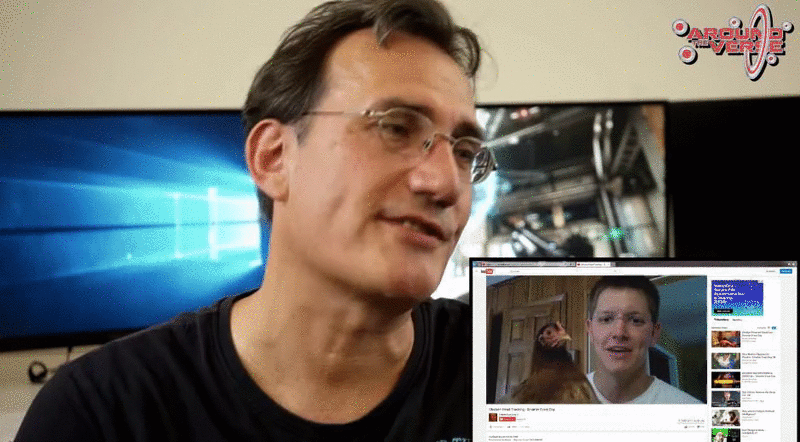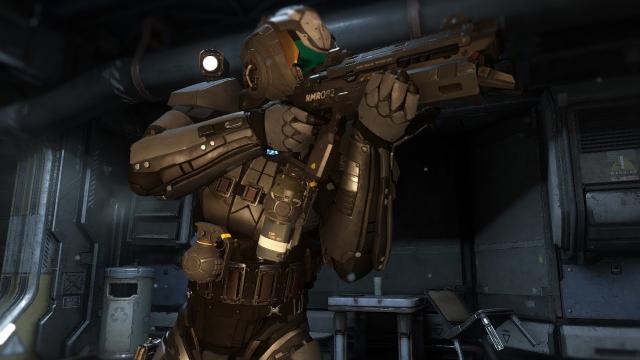Star Citizen’s first-person view isn’t like other games, where you’re essentially in control of a floating camera. That approach is tried and true, but not wholly realistic. In the preposterously ambitious space game, your view and your body are one-in-the-same, just like in a real human body. Problem: Turns out, human bodies have a lot going on.
As we (and now, in a truly mammoth feature, Kotaku UK) have reported on multiple occasions, Star Citizen might be too ambitious for its own good. This could be read as an example of that, or it could be demonstrative of cool, game-changing stuff that comes out of a “jack of all trades, master of the whole damn universe” approach. Time will tell.
Either way, Star Citizen’s first-person camera owes its functionality to birds. Yes, birds.
In a recent developer diary, lead animation engineer Ivo Herzeg explained all the trouble his team went through to shove virtual eyeballs into Star Citizen characters’ faces. First, they tried simply placing a camera on a character’s head, and it was like controlling a bobble head. Each motion of the body caused the view to dart all over the place.
Fun fact: This happens with real human bodies too, but subtle, automatic reactions in the eyes and brain correct for it. When we walk, it’s smooth, like our eyes are luxuriating in pristine slabs of butter. So first, the Star Citizen team added eye stabilisation, which is basically counter-rotation of the eyes to make up for motion of the head and body. They did it by putting a focus point in the distance for the camera to stay trained on.
Problem solved? Not entirely. Herzeg said that eliminated about 80 per cent of the bouncing. However, eye stabilisation alone became troublesome in confined areas (say, on a space station) or strafing in front of walls. Worse, stopping in front of walls produced an ugly bounce back effect, one that definitely doesn’t happen in real life… unless you slam full-force into something. Those issues added up to a lack of realism and a surplus of motion sickness.
“This issue was keeping us busy for a while,” said Herzeg, “so we spent time trying to understand how we humans are doing visual stabilisation. It turned out, it’s a pretty complex mental process, and there wasn’t a practical way to get that into our first-person camera.”
Techniques used in real-life handheld cameras didn’t cut it either, so they had to figure out an alternative method. That’s where birds came in.
“We learned that birds, or at least most types of birds, they have a pretty interesting problem,” said Herzeg. “They can’t roll their eyes around the way humans can. That makes it hard for them to keep their vision stable and move their body at the same time.”
“If you can’t keep your vision stable by moving your eyes,” he added, “then the next logical step is to try to do the opposite. Just keep the head stable. And that’s what they do. Birds have long necks, so they just counter-translate the body motions. It’s kind of a camera stabiliser invented by nature.”
In short, this is why Star Citizen’s first-person view doesn’t jolt around like your brain’s trapped in the version of Hell that’s just jumping castles for all eternity:

The more you know!

Comments
9 responses to “Star Citizen’s First-Person View Is Based On Birds”
So basically a floating camera like every other FPS game?
Slightly more complicated than that due to there only being one model and no fake model for first person view vs what everyone else sees.
this is obligatory https://www.youtube.com/watch?v=9hBpF_Zj4OA
“Worse, stopping in front of walls produced an ugly bounce back effect, one that definitely doesn’t happen in real life…”
I cant play Space Engineers for this reason alone. I’ve had some very extreme experiences and nothing makes me motion sick except for that stupid rebound head bobble in space engineers.
Isn’t this an issue that would’ve been solved over 10 years ago? FPS’s are one of the most popular genre’s and have been since the late 90s.
Seems to me they’re spending a lot of time reinventing the wheel. It’s especially weird when you consider the engine they’re using. Which is designed for FPSs.
Will be really interesting when this thing finally comes out. After Bioshock Infinite and Deus Ex: MD I’m hedging my bets. I’ve been really disappointed by big releases lately. Can’t remember the last games apart from TLOU and Witcher 3 that I really felt on a deep level.
it’s an issue that’s been mostly ignored since the common answer is a ‘good enough cheat’ rather than solving the problem itself. It’s kinda like how so many third-person games would just slide a model along the ground playing a running animation – you can really see when a dev has tried to make the feet ‘connect’ with the ground using things like physics systems instead. (which is one of the big reasons Prince of Persia: The Sands of Time and Gears of War have such a great, weighty feel to just running the characters around the environment)
I think it’s more the difference of 1980’s surgery vs 2010’s keyhole surgery – yeah both do the job – but way is a significant advancement.
We shouldn’t try to find a new way of doing things because it already works said no inventor ever, and in the very next sentence you complain about game sequels that have disappointed you. 99% of those games had no body attached to the camera. Was easy to see when you enabled the Camera mode in Bethesda games, first person you were two hands and that’s it. This is a problem nobody has bothered to solve because it was easier to just have a Rayman body with magic hands.
This sounds like quite the technical achievement. However, we’re not researchers of game mechanics, we’re consumers. In the end the question is, is there a noticeable difference to gameplay gained using this approach to the FPS camera.
As a research scientist, however, I can say, “This is what we call the difference between trying to replicate real life, and simulating real life”. In a simulation, we make approximations in areas we deem insignificant to the end result, primarily to simplify the simulation so we can focus resources on the areas of interest.
Yes there is – however it’s impossible to describe just how much of a difference it will make.
You know how if you play a game on PC with a 144hz monitor with Gsync(or equivalent) on and you think isn’t this how games always are? You play for an hour then load up the same game on a console that is locked to 30FPS and you’re like “Ohhhhhhhhhh wow this is so bad”
Basically you won’t notice it when playing but you’ll notice and feel it missing when you play other games without it. I mean you might feel the game is just wrong when playing it for the first time – but you wont know why.
I hear what you’re saying but you don’t know that. Yet. We won’t until we play the game.